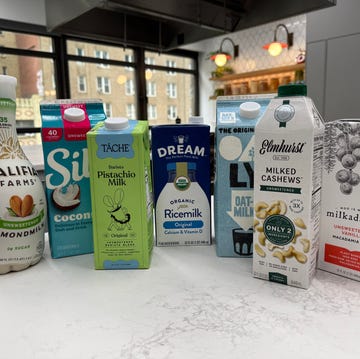1Milkman
 Getty
GettyEvery morning in the 1950s, like clockwork, the milkman would deliver bottles and jugs filled to the brim with milk. If you were lucky, sometimes he would even deliver other kitchen essentials like eggs and butter. With the rise of home refrigeration the milk stayed, but the profession expired. Maybe if they delivered cookies too, milkmen would've had a better chance?
2Elevator Operator
 Getty
GettyElevators didn't always move with the simple push of a button. Back in the day, elevator operators were in charge of controlling everything from the doors and direction to the speed and capacity of the elevator car — a lot of layers, or should we say levels, to the position. In the '50s, automatic elevators became more common and individuals had to push their own button (gasp!).
Advertisement - Continue Reading Below
3Hacker
 Getty
GettyWe wish we could tell you that hackers (computer hackers, that is) no longer exist, but unfortunately, these working men were more handy with trees than HPs. Hackers were known as woodcutters and were axed, yet again, due to technological advancements.
4Linotype Operator
 Getty
GettyLife without a backspace?! We can't even imagine, but former linotype operators definitely can. These highly skilled workers used the linotype, a hot metal typesetting system, to produce the daily newspaper in the late 1880s. Phototypesetting was created in the early 1960s and rapidly replaced all operator positions.
Advertisement - Continue Reading Below
5Gandy Dancer
 Getty
GettyA Gandy Dancer actually has nothing to do with movin' your hips. The title is slang for a railroad worker who maintained the tracks years before the work was done by machines.
6Chimney Sweep
 Getty
GettyThis job has been around for hundreds of years, peaking during the Industrial Revolution and then falling into a steep decline after the adoption of electric and gas alternatives. Fun fact: Door-to-door chimney sweeps were called knellers.
Advertisement - Continue Reading Below
7Computer
 Getty
GettyIf you've seen Hidden Figures, then you know what a computer is — and no, it's not the technology that you're on right now. Dating back to the early 17th century, computers, usually women, would calculate figures and crunch numbers all day long by hand. Yup, that's right, no calculators allowed.
8Billy Boy
 Herald Sun Image Library/Argus
Herald Sun Image Library/ArgusPinky's up! In the '50s and '60s, Billy boys were young apprentices in training that would make tea for the other men at work. Seems strikingly similar to an intern grabbing a load of Starbucks, right? Some things never change.
Advertisement - Continue Reading Below
9Bowling Alley Pinsette
 Getty
GettyIf you loved to play games and needed some extra change, a pinsetter position at a bowling alley was right up your alley. The workers usually manually organized the pins for every game. The job was sent to the gutter once the mechanical pinsetter was invented by Gottfried Schmidt in 1936.
10Switchboard Operator
 Getty
GettySwitchboard operators connected long-distance calls and directed communication before digital exchange switched up the game. By the early 80's the position became obsolete.
Advertisement - Continue Reading Below
11Typist
 Getty
GettyTypists are still in-demand today, just without the typewriter. In the 1940s, typists were popular positions within the publishing, administrative and clerical industries. The role today has simply been upgraded with computers.
12Catchpole
 Getty
GettyDeriving from the old english word "cace-" and the medieval Latin word "pullus" (a chick), the job title catchpole, a.k.a. a debt collector, was born. There are still debt and tax collectors today, but none that go by this bizarre British title.
Advertisement - Continue Reading Below
13Clockwinder
A clockwinder did exactly what the name insinuates — wind clocks. It was only a matter of time before electric clockwinders, which required less maintenance and fewer repairs, were produced during the Industrial Revolution.
14Icemen
 Columbia Valley Pioneer
Columbia Valley PioneerIn the early 1800s, ice cutting was the common task of hand-sawing individual ice blocks from lakes and rivers to help store cold food throughout the winter. Then refrigerators were invented and the heavy-lifting job chilled out.
Advertisement - Continue Reading Below
15Eggler
 Getty
GettyWe're not going to lie, there's nothing too eggsquisite about this job. The egg carton was invented in 1911, and Egglers began to sell bulk batches of eggs and sometimes switched it up with other poultry. At the end of the day, they couldn't wing it with just eggs and poultry and added other food to the mix. Today, you can find these folks at farmers' markets.
16Fuller
 Getty
GettyA fuller is a job that every parent can relate to — washing clothes. In the medieval era, fullers cleaned cloth to rid the textiles of oil and dirt. Afterward, the material was bound together to create clothing and other items.
Advertisement - Continue Reading Below
17Hobbler
 Getty
GettyWe assume a hobbler got its nickname in the mid-1800s from hobbling around and balancing on boat decks, but the real job was to tow river and canal boats. Similar deckhand positions still exist today, but they don't go by hobblers.
18Hush Shopkeeper
 Getty
GettySneaky hush shopkeepers got their name from keeping their liquor sales on the hush-hush during prohibition. Now, you can find a cocktail after a stressful day of work just about anywhere. Cheers!
Advertisement - Continue Reading Below
19Knockerupper
 Getty
GettyBefore the first mechanical alarm clock was invented in 1847, people hired knockeruppers to help shoot peas at their windows or tap the glass with long poles so they didn't oversleep for work or during an afternoon snooze. Then the alarm was born, which we all now have a love-hate relationship with.
20Lamplighter
 Getty
GettyA lamplighter in the late 1800s and early 1900s was precisely that — someone who is employed to light street lamps. Only a small number still exist today as the majority of street lighting is now electric.
Advertisement - Continue Reading Below
Advertisement - Continue Reading Below
Advertisement - Continue Reading Below

































